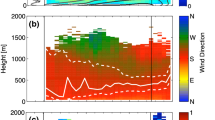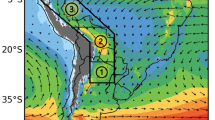Abstract
Two cases of low-level jet events and the interaction of the involved physical processes are investigated. The vertical distribution of the dominant atmospheric motions is studied, using data from a SODAR-RASS system and in situ instrumentation, at a coastal region of the Eastern Mediterranean (Messogia Plain in Attica—Greece). The first low-level jet (LLJ) case was observed during the cold period, after the passage of a cold front and could be characterized as purely synoptic. Coherent inertial motions were found to follow the frontal surface at both the wind components, with larger amplitudes at the alongfront wind component, a fact consistent with the deformation theory. The contribution of the diurnal cycle was found weak in both the components, due to the cloudiness and the small diurnal temperature range, while the synoptic scale dominated the northerly wind component. The second LLJ case represents two successive summertime large-scale jets. The absence of cloudiness and the increased solar radiation provided a favorable environment for the development of local flows which interacted with the synoptic wind field. This interaction led to a LLJ with an oscillating core and a variable depth. The diurnal cycle had a strong imprint on the wind component along the sea breeze direction (easterly), while the synoptic variations dominated the northerly wind component. Strong amplitudes of a coherent quasi 2-day variation were also found in both the cases.













Similar content being viewed by others
References
Banta RM, Newsom RK, Lundquist JK, Pichugina YL, Coulter RL, Mahrt L (2002) Nocturnal low-level jet characteristics over Kansas during CASES-99. Bound Layer Meteor 105:221–252
Blackadar AK (1957) Boundary layer wind maxima and their significance for the growth of nocturnal inversions. Bull Am Meteor Soc 38:283–290
Blumen W (1997) A model of inertial oscillations with deformation frontogenesis. J Atm Sci 54:2681–2692
Blumen W (2000) Inertial oscillations and frontogenesis in a zero potential vorticity model. J Phys Oceanogr 30:31–39
Bonner WD (1968) Climatology of the low level jet. Mon Weather Rev 96:833–850
Bowen BM (1996) Example of reduced turbulence during thunderstorm outflows. J Appl Meteorol 35:1028–1032
Clark RR (1975) Meteor wind measurements at Durham, New Hampshire (43o N, 71o W). J Atm Sci 32:1689–1693
Clark RR (1989) Meteor the quasi 2-day wave at Durham (43oN): solar magnetic effects. J Atm Terr Phys 51:617–622
Coulter RL, Kallistratova MA (2004) Two decades of progress in SODAR techniques: a review of 11 ISARS proceedings. Meteorol Atm Phys 85(1–3):3–20
Davies H, Muller JC (1988) Detailed description of deformation-induced semigeostrophic frontogenesis. Q J Roy Meteor Soc 114:1201–1219
Helmis CG, Asimakopoulos DN, Papadopoulos KH, Kassomenos JA, Kalogiros JA, Papageorgas PG, Blikas S (1997) Air mass exchange between the Athens Basin and the Mesogia plain of Attika, Greece. Atmos Environ 31:3833–3849
Helmis CG, Kalogiros JA, Assimakopoulos DN, Soilemes AT (2000) Estimation of potential temperature gradient in turbulent stable layers using acoustic sounder measurements. Q J Roy Meteor Soc 126:31–61
Hoskins BJ (1975) The geostrophic momentum approximation and the semigeostrophic equations. J Atm Sci 32:233–242
Hoskins BJ, Bretherton FP (1972) Atmospheric frontogenesis models: mathematical formulation and solution. J Atm Sci 29:11–37
Huang NE, Coauthors (1998) The empirical mode decomposition and the Hilbert spectrum for nonlinear and non-stationary time series analysis. Proc Roy Soc Lond A 454:903–995
Huang NE, Shen Z, Long SR (1999) A new view of nonlinear water waves: the Hilbert spectrum. Annu Rev Fluid Mech 31:417–457
Huang NE, Shih HH, Shen Z, Long SR, Fan KL (2000) The ages of large amplitude coastal seiches on the Caribbean coast of Puerto Rico. J Phys Oceanogr 30:2001–2012
Huang NE, Chern CC, Huang K, Salvino LW, Long SR, Fan KL (2001) A new spectral representation of earthquake data: Hilbert spectral analysis of station TCU129, Chi-Chi, Taiwan, 21 September 1999. Bull Seismol Soc Am 91:1310–1338
Li H, Yang L, Huang D (2005) The study of the intermittency test filtering character of Hilbert–Huang transform. Math Comput Simul 70:22–32
Lundquist JK (2003) Intermittent and elliptical inertial oscillations in the atmospheric boundary layer. J Atm Sci 60(21):2661–2673
Mitchell MJ, Arritt RW, Labas K (1995) A climatology of the warm season great plain low-level jet using wind profiler observations. Weather Forecast 10:576–591
Mori Y (1990) Evidence of inertial oscillations of the surface wind at Marcus Island. J Geophys Res 95:11777–11783
Muller HG (1972) Long-period meteor wind oscillations. Phil Trans R Soc Lond Ser A 271:585–598
Ostdiek V, Blumen W (1997) A dynamic trio: Inertial oscillation, deformation frontogenesis, and the Ekman–Taylor boundary layer. J Atm Sci 54:1490–1502
Palo SE, Avery SK (1996) Observations of the quasi-two-day wave in the middle and lower atmosphere over Christmas Island. J Geophys Res 101(12):833–846
Rilling G, Flandrin P, Gonçalvès P (2003) On empirical mode decomposition and its algorithms. Proceedings of the 6th IEEE/EURASIP workshop on nonlinear signal and image processing (NSIP’03), Grado, Italy
Whiteman CD, Bian X, Zhong S (1997) Low-level jet climatology from enhanced Rawinsonde observations at a site in the Southern Great Plains. J Appl Meteorol 36:1363–1376
Zhong S, Fast JD, Bian X (1996) A case study of the great plains low-level jet using wind profiler network data and a high-resolution mesoscale model. Mon Weather Rev 124:785–806
Acknowledgments
This study was supported by the project PENED 2003, which is funded by the European Union (75% of the public expenditure), the General Secretariat for Research and Technology—Ministry of Development (25% of the public expenditure), and the private sector (Athens International Airport S.A.—AIA), within the frame of Measure 8.3 of the Operational Program “Competitiveness”—Third Support Framework. The authors would like to thank Dr. Helena Flocas from the University of Athens for the discussions and suggestions regarding the analysis of the synoptic conditions, Mr. Michael O’Connor from AIA for his assistance and helpful suggestions during this study, and the AIA Authorities for providing the SODAR-RASS and the 20-m mast data.
Author information
Authors and Affiliations
Corresponding author
Appendix
Appendix
Empirical mode decomposition is consisted by the following steps:
-
(1)
First, in a given time series X(t), the local maxima and minima are identified and then connected by cubic spline lines to create the upper and lower envelopes that cover all the data between them.
-
(2)
The mean m 1(t) of the two envelopes is calculated and removed from the time series:
$$ X(t) - m_{1} (t) = h_{1} (t), $$(4)where h 1(t) may be the first component of the time series. The component h 1(t) is considered to be an IMF if the number of extrema and the number of zero-crossings in h 1(t) are identical or differ by, at most, one.
-
(3)
If h 1(t) is considered to be an IMF [c 1(t)], then it is removed from the original time series:
$$ X(t) - c_{1} (t) = r_{1} (t) $$(5)and the residual r 1(t) is processed similarly (steps 1–2) to find successive IMFs. If h 1(t) does not fulfill the criterion of the IMF, it is treated again as X(t) in Eq. 4: a new m(t) is calculated, the resulting residual is tested against the IMF criterion, and so on. This sifting process is necessary to separate the finest local mode from the data based only on the characteristic timescale.
-
(4)
The above process is repeated to find several c(t) and r(t) and eventually, at step n, only a linear trend remains. The c 1…n (t)s are considered IMFs.
The Hilbert transform (second step) is applied to each IMF to extract the instantaneous frequencies and amplitudes, as a function of time, of each IMF. The Hilbert transform \( \tilde{h}(t) \) of a time series h(t) may be defined as the convolution integral of h(t) and (1/πt), written as:
Then the complex analytic signal associated with h(t) and \( \tilde{h}(t), \) z(t), can be expressed as:
A(t) is the amplitude, u(t) is the phase which can be differentiated to find the instantaneous frequency, ω:
The instantaneous frequency, calculated by the Hilbert transform, should be understood as the frequency of a sine wave that locally fits the signal, rather than the frequency of a sine wave that is present throughout the entire time series signal. In this way, an energy–frequency–time distribution (known as the Hilbert spectrum) is calculated. This frequency–time distribution of the amplitude is designated as the complete Hilbert amplitude spectrum—H(ω,t), which represents the distribution of energy in timescales corresponding to different physical processes. Compared with the traditional Fourier analysis where the amplitude is only a function of frequency and not both frequency and time, the HHT method preserves the time localities of events and is suitable for non-stationary signal analysis (Li et al. 2005). With the Hilbert Spectrum defined, we can also define the marginal spectrum that offers a measure of the total amplitude contribution from each frequency value:
Rights and permissions
About this article
Cite this article
Sgouros, G., Helmis, C.G. Low-level jet development and the interaction of different scale physical processes. Meteorol Atmos Phys 104, 213–228 (2009). https://doi.org/10.1007/s00703-009-0028-5
Received:
Accepted:
Published:
Issue Date:
DOI: https://doi.org/10.1007/s00703-009-0028-5




